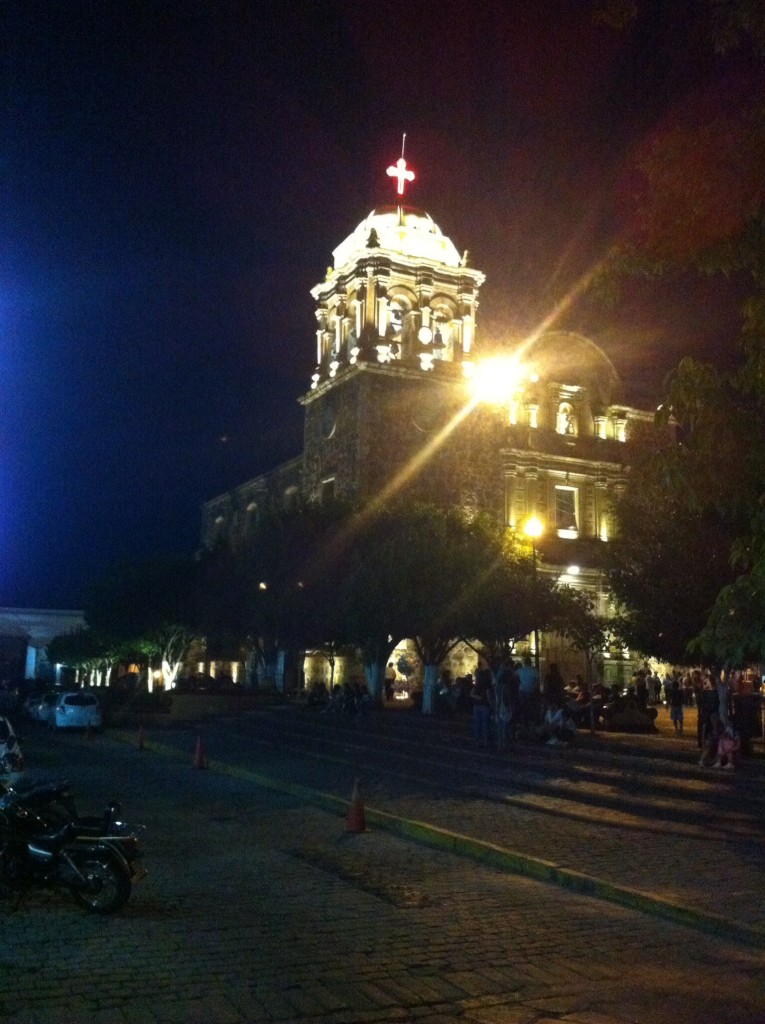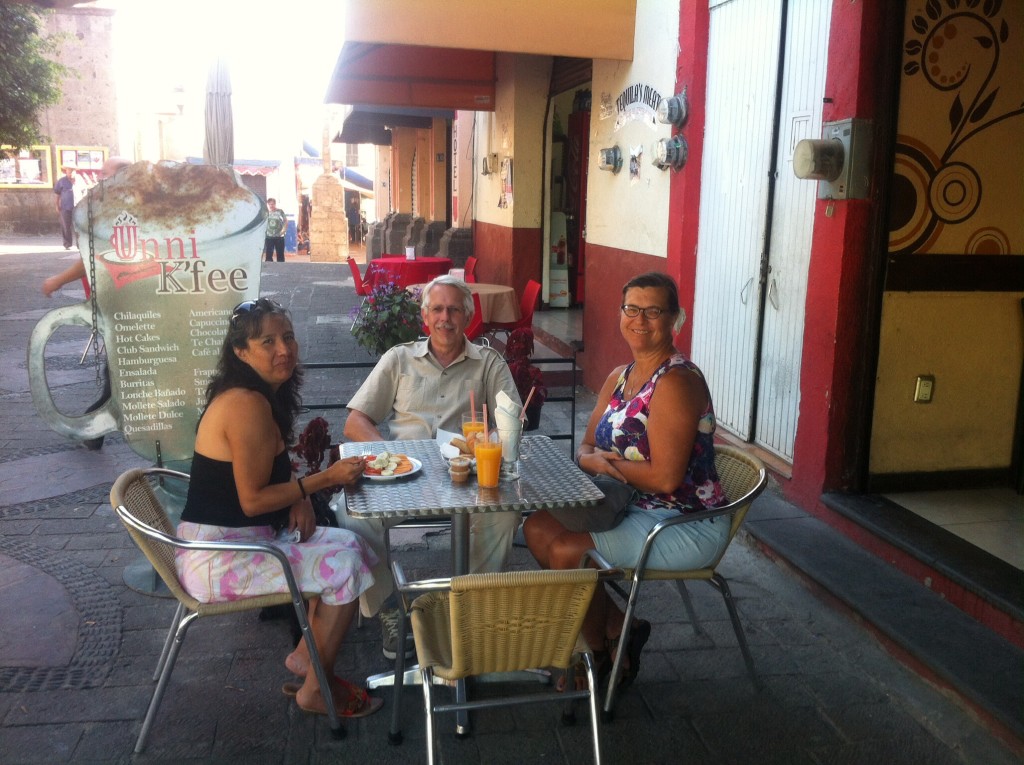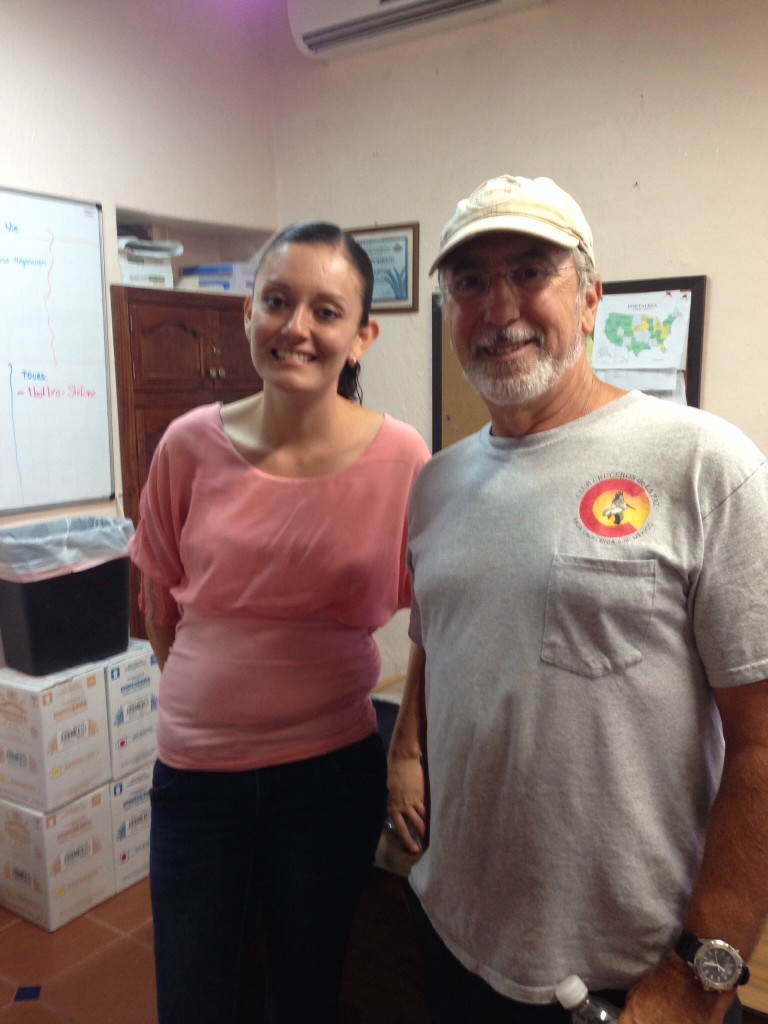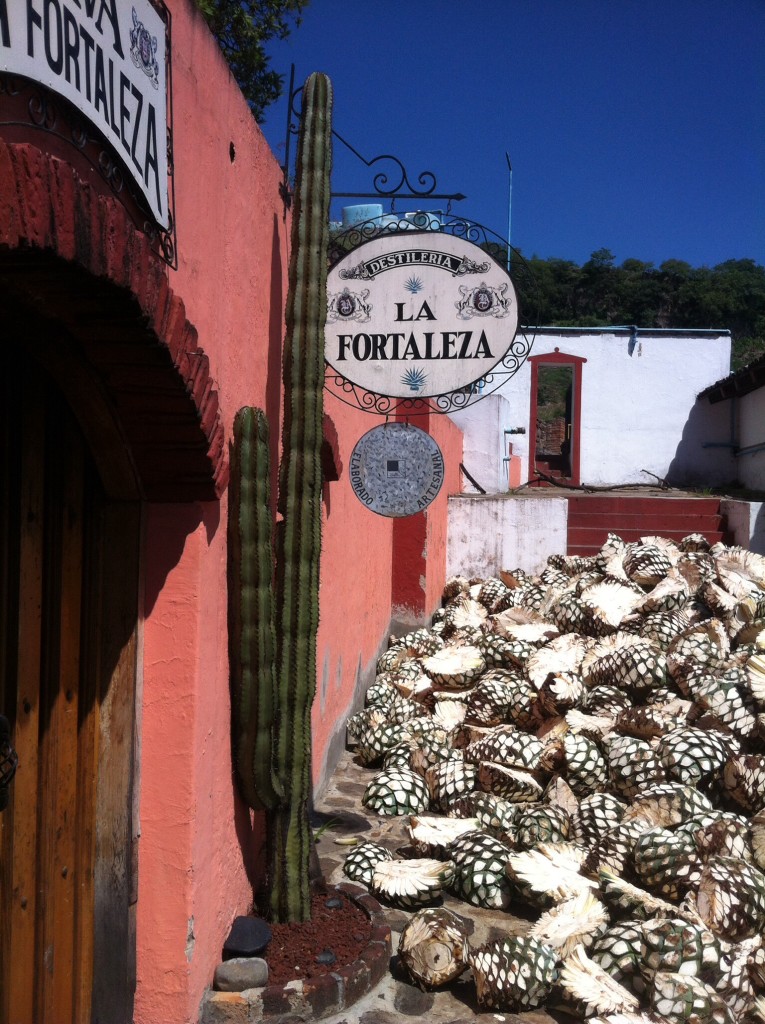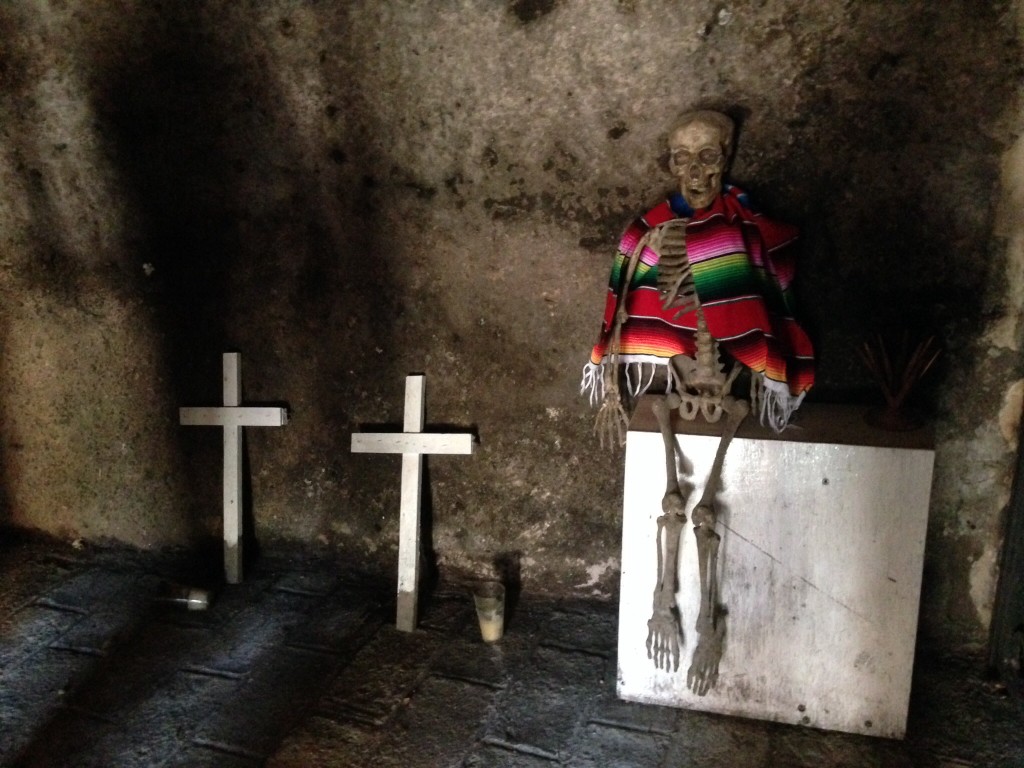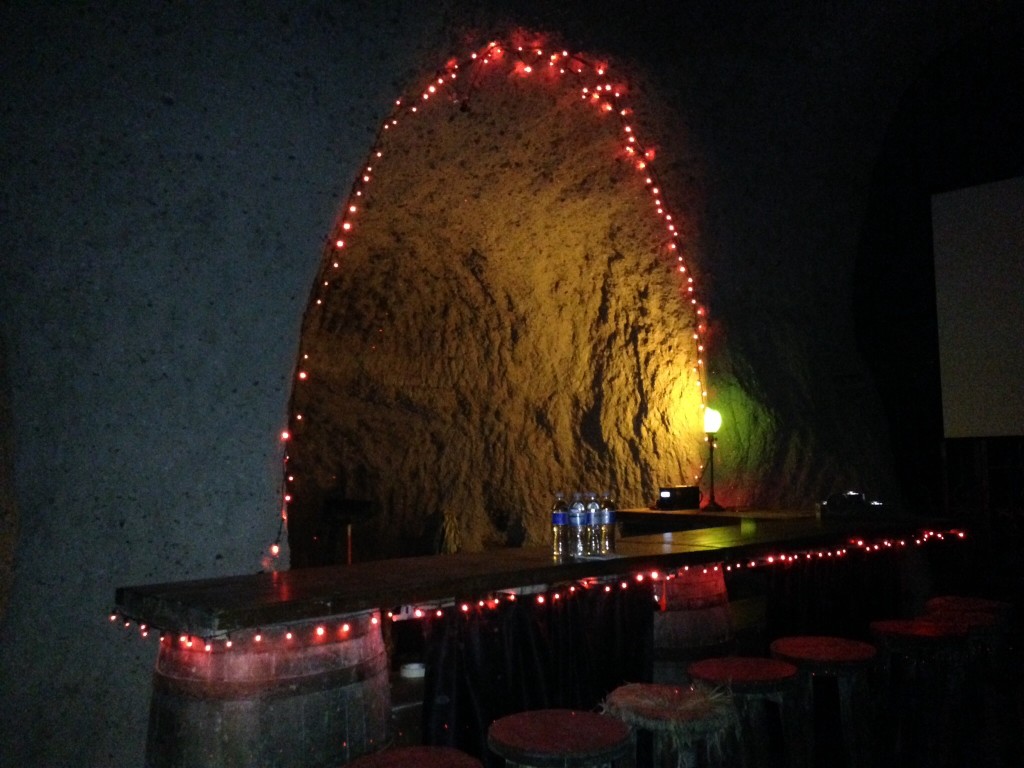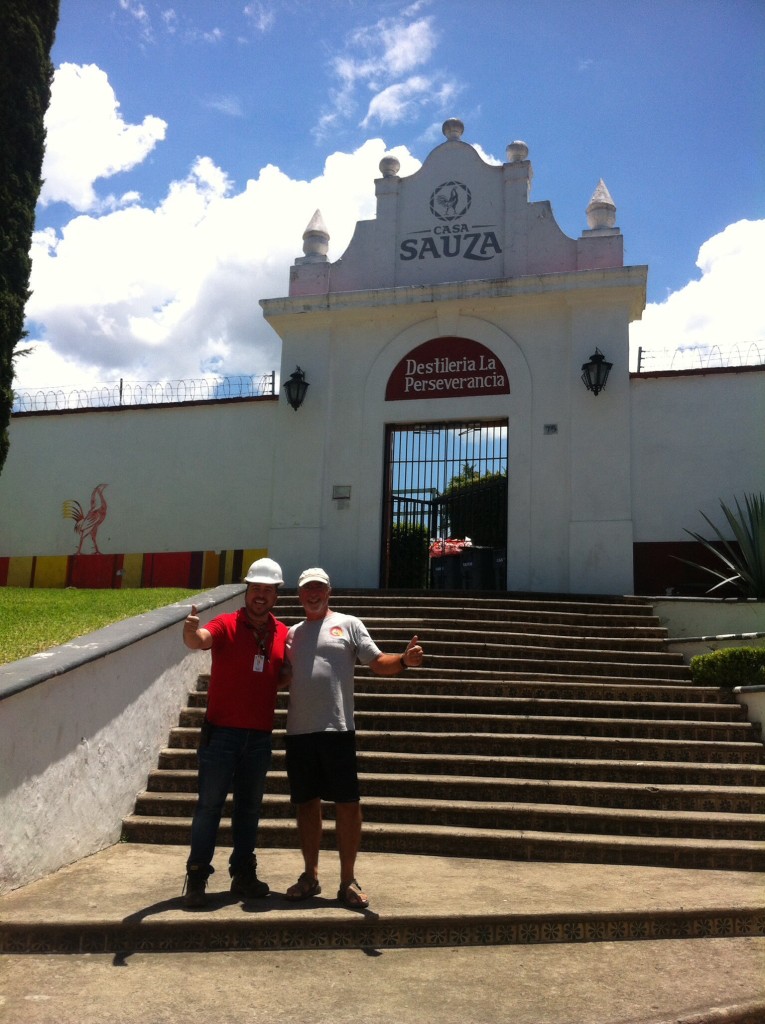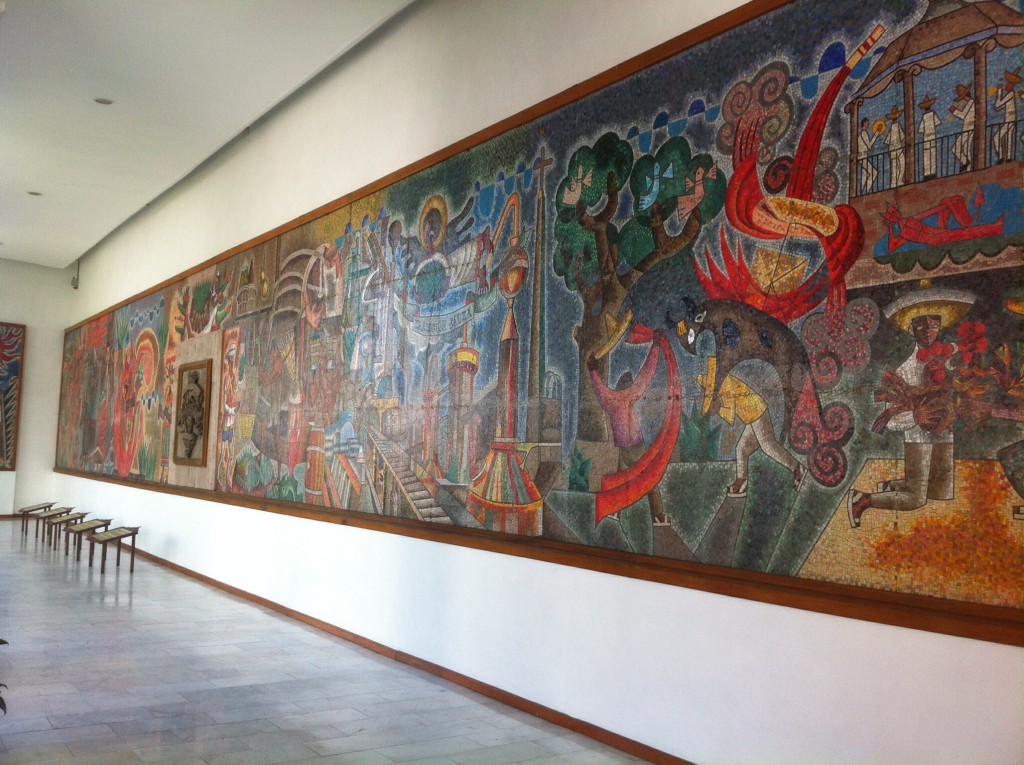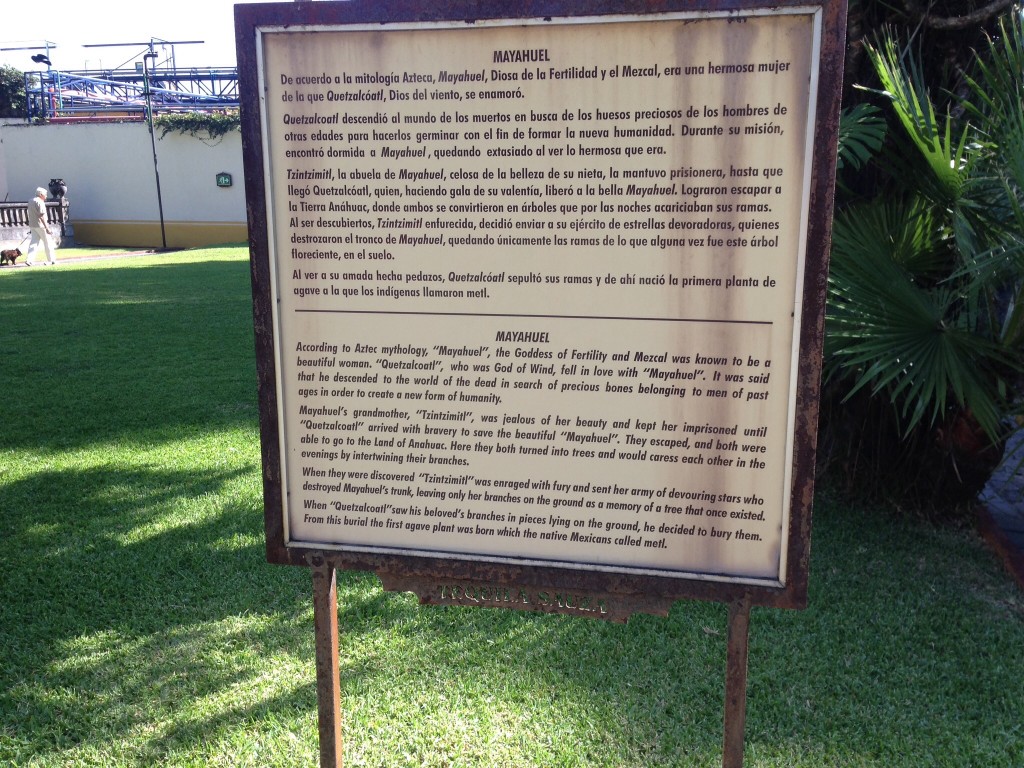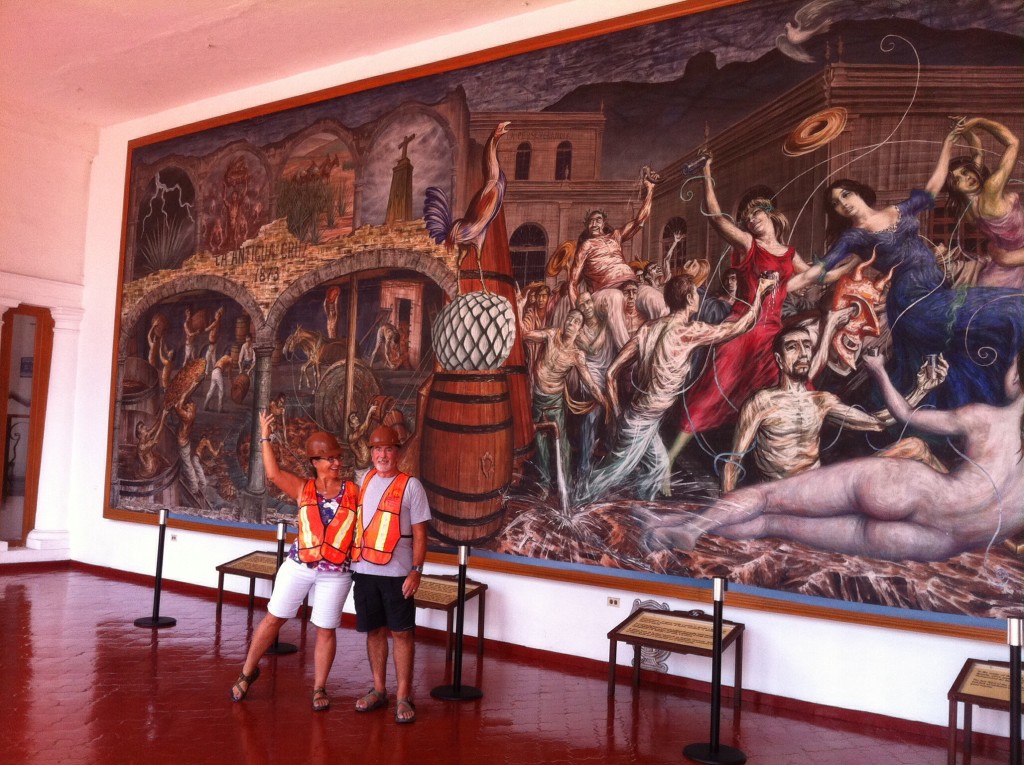
Rick and Cindy in front of the mural at the Sauza distillery. The mural depicts a tequila party; after a few shots of her own, Cindy poses as the woman in the red dress!
Our dockmate Lou and his Mexico City date Rosa invited us to join them driving to the town of Tequila for a few days’ break from the heat of the Puerto Vallarta summer. It was great to get out of town into the mountains, to see some different scenery, to practice my Spanish at a higher level with Rosa, to enjoy walking around the delightful town of Tequila, to learn a whole lot more about our favorite Mexican beverage, and not least, to savor some premium tequila in the place of its origin!

The Blue Agave plant. After a 4+ hour drive through well-maintained, winding mountain roads, we started seeing blue agave crops popping up all around us
We stayed in a small, older hotel a mile or so from the Main Street of Tequila for $20 USD per night plus an extra $1.75 for air conditioning. It was clean, the bed was firm, and the shower had hot water – what more could you ask for? We then headed into town and parked on the main square to enjoy tamales and corn from street carts while eating at a sit-down table offered to us by the nearby restaurant as long as we ordered drinks from them. All delicious. At 9:00 p.m., the bells from the Cathedral on the square rang, and everyone in the square, including the four of us, stood up and faced the cathedral for a few moments and then sat down when the bells stopped ringing. Rosa clarified with the nearby table that the Father of the Cathedral blesses everyone at 9:00 p.m. each night. Thanks, Father, any blessing is very much appreciated!
The town of Tequila itself is very alluring, with cobblestone/brick streets, gaslight-style streetlights in the Centro, the main square with the Cathedral that is always well populated with families and food vendors, a few sidewalk cafes and bars, inexpensive accommodations and food, and lots of friendly people who mostly only speak Spanish. It is only a 40 minute drive from Guadalajara, the second most important city in Mexico. Rick said he would consider coming here for a while to just hang out and study Spanish. Yeah, right, we would get in a whole lot of studying done in a town that is named for our favorite Mexican alcoholic beverage!
Lou was an excellent tour guide, having been there a few times before. He had his heart set on taking us for a guided tour of the Fortaleza Distillery, even though tours there were by appointment only. He was persistent, and was able to persuade the coordinator of Forteleza tours, Claudia, to give us a private tour in English. She was on her way to Guadalajara for the day but took time out of her busy schedule to show us around.
Forteleza is unique in many ways. The owner, Guillermo, is the grandson of the third generation Sauza family patriarch who sold the family’s tequila business to foreign owners. (Sauza is now owned by a Japanese company). Guillermo wanted to recreate the original process of making tequila using original equipment, so he bought back the original factory, then defunct, from the Sauza company, and restored it to working order. The stills they use are over 100 years old, as is the steam-infused oven where the cook the “piñas,” or the hearts of the blue agave plant. They actually use the original “tahona”, a large stone wheel, that revolves in a circle to crush the piña after it has been steamed.

The workers at Forteleza standing in the pit where they wash and crush the cooked agave plant fibers three separate times to extract as much juice as possible before fermenting. The big stone wheel barely visible in the center background will crush the fibers by being driven round in a circle inside the pit
For a detailed account of the traditional way of making tequila, see this link: http://izkalitequila.com/blog/the-7-steps-of-tequila-making
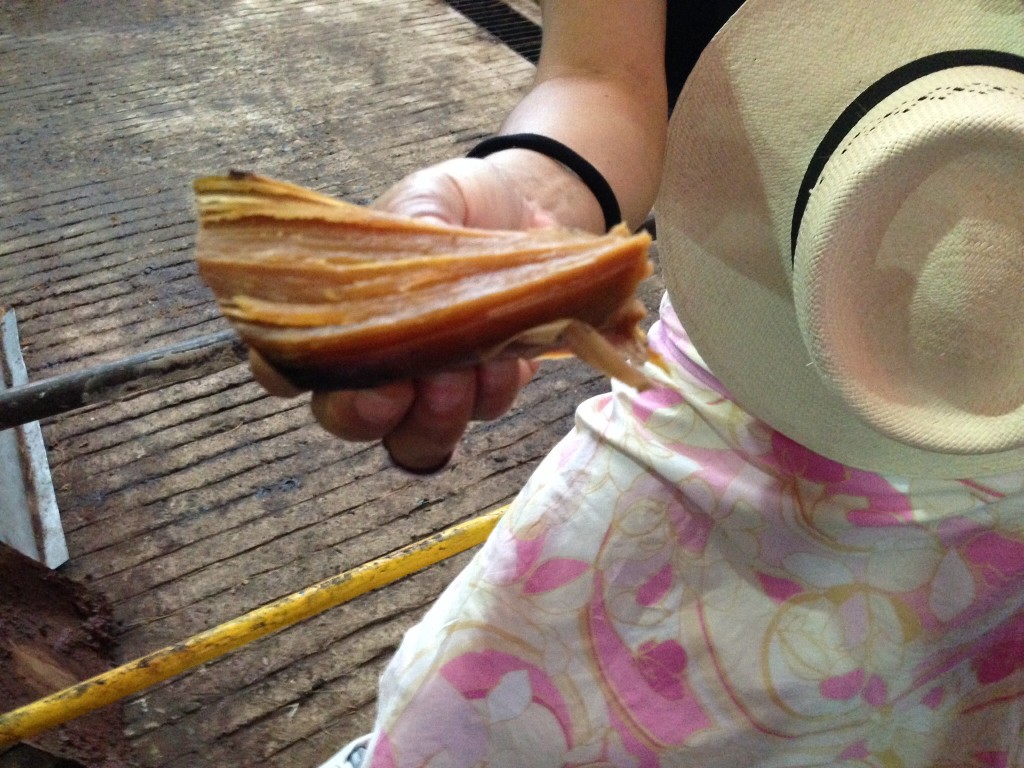
A piece of steamed agave heart that Rosa peeled off a stack and shared with us. The fiber is unedible but the juice is very sweet. You chew it and then discard the fiber. Rosa’s father used to buy this in the markets for her as a child; they no longer sell it commercially
After touring the distillery, Claudia showed us the tasting room for exclusive guests hidden down dark cave passageways. They have a Day of the Dead party the public can attend in the caves for a fee – wouldn’t that be fun! I imagine you would have to get tickets way in advance.
Forteleza was certainly a special place. Even the bottles they use are individually hand blown. We had tasted their añejo the night before, and definitely loved it. It is almost impossible to find because the tequila hasn’t been marketed a lot yet. Needless to say, we went home with a bottle of their finest.
After Forteleza, Rick and I were lucky enough to get a private tour in English of the Sauza distillery by their Operations Coordinator, Rafael. He doesn’t usually give tours; he supervises the tour guides, amongst other duties. But he made the mistake of catching me as I was passing the distillery earlier and I got him to commit to a tour in English at an unscheduled time, and then we came back later to collect on his promise!
Rafa gave probably the best tour I have ever had. He was smart and funny, very well practiced at the art of giving tours, and knew so much. He answered all of our questions, gave us a two hour tour when it should have only been one hour, and finished it off with not only the customary complementary margarita, but also with two shots of Sauza’s premium tequila, Tres Generaciónes añejo. Of course, we bought a bottle of that too!
It was quite the contrast to go from a tour of Forteleza to a tour of Sauza, especially since both come from the same heritage. It was the grandfather of the owner of Forteleza who sold the Sauza company and name to foreigners, and Sauza still celebrates the founding three generations of the Sauza family. But the Sauza company has taken a huge leap in the direction of technology, markets to over 70 countries around the world, and has several different labels (Hornitos, Tres Generaciones, Hacienda, 100 Años, and Sauza XA). ALL of these labels are produced nowhere but in the distillery we visited, and it is huge. Sauza is one of the three biggest producers and oldest distilleries in the Tequila region of Jalisco, the others being Cuervo and Herradura.
How much did we learn about Tequila from Rafa? Let me count the ways:
a double-distilled liquor from the agave plant can only be called tequila if it is from a blue agave plant grown and processed in either the state of Jalisco, Mexico or in very small, specific municipalities of four other Mexican states; it can be called tequila if at least 51% of the juices used to make it are from the blue agave plant, but the other 49% can be made from a specific list of other plants including sugar cane, but not other varieties of agave; the bottle must say pure agave, 100% agave, or 100% blue agave to not be the 51% variety, and all of those expressions mean the same thing; silver and blanco tequila are the same thing, and have never touched an oak barrel but can be stored in stainless steel containers without aging; “joven” tequila has been aged in white oak barrels up to two months; reposado tequila has aged in white oak barrels from 2 to 11 months; añejo tequila has aged from 12 months to three years, and extra añejo tequila has aged over three years; “ultra” añejo is a marketing scheme where the color of añejo has been changed to clear through a carbon filtering process; most tequilas are aged in oak barrels that have been scorched to a greater or lesser extent, and some of the “black” tequilas get that way by aging in an extra-scorched barrel; “gold” tequila has color added artificially and is not aged; the reason that Hormitos is lighter color is that they age it in non-scorched barrels; Sauza processes their piñas differently by not steaming the piñas at all, but instead by shredding the raw piñas and extracting the juices with huge processing machines, thereby retaining more of the herbal fragrances of the tequila and also increasing production … I am sure I missed repeating something we learned from Rafa but if you have any questions about tequila, be sure you go visit him!
Rafa also had a very specific way to taste tequila, which he taught us after extracting a glass of their most expensive tequila, XA, extra añejo, from the barrel for us to try: first, smell it; next, wet your lips and the tip of your tongue with just a little sip; next, take a bigger sip and swirl it around in your mouth for at least three seconds; next, inhale, swallow, and then do a long exhale through your nose. That final step will give you the full range of flavors and aromas. Well, this is a different method than other tequila connoisseur friends of ours taught us, but I gotta tell ya, there is no doubt you get the full impact of the tequila this way! Every time I did it I felt a little dizzy upon exhale!

Rafael demonstrating his prowess at pouring a glass of extra añejo out of the barrel for our lesson in proper tasting technique
We had already read about how the ancient goddess of fertility and mescal, Mayahuel, ran off with her love Quetzalcoatl, and became entwined trees who loved each other, after which, Mayahuel’s tree trunk was chopped down by the evil stars sent by Mayahuel’s jealous grandmother, leaving only Mayahuel’s branches, which Quetzalcoatl buried in the earth and became agave. But Rafa continued to explain that it wasn’t until lightening struck and burned a wild agave field that the ancient Nahuatl indigenous communities of Jalisco discovered the sweet nectar produced by cooking the heart of the agave plant. So they made lots of juice as a refreshing drink from the burnt field, but after a couple of days, the juice started to ferment and the Indians thought that they were possessed by Mayahuel’s spirit when they drank it. Sometimes I feel like that too!

